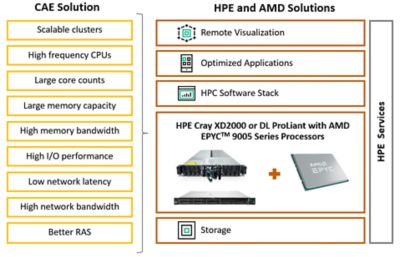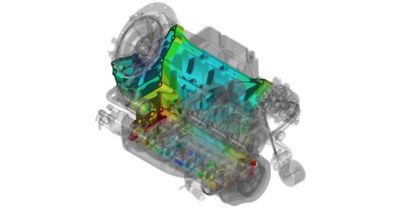-
-
Access Free Student Software
Ansys empowers the next generation of engineers
Students get free access to world-class simulation software.
-
Connect with Ansys Now!
Design your future
Connect with Ansys to explore how simulation can power your next breakthrough.
Countries & Regions
Free Trials
Products & Services
Learn
About
Back
Products & Services
Back
Learn
Ansys empowers the next generation of engineers
Students get free access to world-class simulation software.
Back
About
Design your future
Connect with Ansys to explore how simulation can power your next breakthrough.
Free Trials

Ansys applications play a vital role in helping engineers evaluate and optimize product performance under real-world conditions. To fully realize their potential, these applications require robust computing infrastructure that can efficiently handle large, complex simulations.
To support this need, Ansys and Hewlett Packard Enterprise (HPE), an Ansys high-performance computing (HPC) partner, have developed a best-practices guide to use HPC for Ansys workloads. This resource outlines key challenges manufacturing users often face, along with practical guidance and recommended approaches to help maximize performance and avoid common pitfalls.
Selecting the Right HPC System and Architecture for Ansys Workloads
As Ansys simulations become more complex and integrated, choosing the right HPC system is critical to ensure performance keeps pace with engineering demands. The first step is evaluating whether current infrastructure meets business goals and requirements. Factors such as job turnaround time, available capacity, and system costs should all be considered. Workstations or aging servers may no longer provide sufficient power and performance, potentially slowing product development and limiting a model’s simulation scale.
Running Ansys simulations efficiently at scale requires hardware that delivers balanced compute, memory, and input/output (I/O) performance. Key requirements include high-core-count CPUs with strong memory bandwidth, large RAM capacity, and low-latency, high-bandwidth interconnects.
Modern processors like the AMD EPYC™ 9005 Series meet these demands through large caches, high memory throughput, and scalable architecture. When combined with optimized simulation software and remote visualization capabilities, they enable efficient execution of large-scale structural and multiphysics workloads.
High-performance storage is also essential to avoid I/O bottlenecks, especially for data-intensive simulations and frequent checkpointing.

Example of key infrastructure components aligned with Ansys workloads
Benchmarking Ansys applications on modern HPC systems can help identify performance gaps and guide upgrade decisions. For example, HPE ProLiant servers with AMD EPYC™ CPUs have demonstrated up to 35% higher performance and 25% greater energy efficiency compared to previous generations. Application benchmarks also show substantial gains across key workloads; Ansys LS-DYNA nonlinear dynamics structural simulation software, for instance, delivers up to 82% faster performance on AMD-based systems versus alternative processors.

Simulation of a three-car collision by Ansys LS-DYNA nonlinear dynamics structural simulation software
When selecting system architecture, it is important to align hardware choices with solver characteristics and memory. CPU- and memory-bound applications like Ansys Mechanical structural finite element analysis software and LS-DYNA software benefit from high-core-count processors with large caches and fast dynamic random access memory (DRAM), such as AMD EPYC CPUs. Meanwhile, graphics processing unit (GPU) acceleration is increasingly valuable for Ansys Mechanical applications as well as memory- and compute-intensive tasks like computational fluid dynamics (CFD) simulations using Ansys Fluent fluid simulation software, which can significantly reduce runtime when paired with AMD Instinct™ GPUs and their high-bandwidth memory. With the Fluent GPU solver, simulations that once took weeks or months can now be completed in hours or days. And Ansys Mechanical software continues to advance heterogeneous computing with expanded support for AMD GPUs in 2024 and a mixed CPU-GPU solver in 2025 that significantly boosts speed, scalability, and memory efficiency.
For maximum flexibility, hybrid infrastructure models — combining CPU-only and GPU-accelerated nodes — allow compute resources to be allocated according to workload needs. Tailored environments like these help maximize throughput and efficiency while ensuring readiness for future Ansys workloads.
Best practice: Regularly evaluate infrastructure to ensure it meets the evolving demands of Ansys solvers. Modernize when needed to maintain scalability, efficiency, and performance.
Hybrid Cloud as a Deployment Strategy
While cloud computing is increasingly used for enterprise workloads, computer-aided engineering (CAE) presents unique challenges that require careful planning. Simulation workloads tend to be long-running, resource-intensive, and license-constrained. These factors can limit the cost-effectiveness of pure public cloud strategies, particularly when compared to running simulations on bare-metal infrastructure with predictable performance and resource control.
That said, hybrid cloud solutions offer a compelling middle ground. This could be a valuable solution when running burst workloads, evaluating new solver capabilities, or executing proof-of-concept studies without committing to permanent infrastructure expansion.

Hybrid cloud environments combine on-premises infrastructure with cloud-based resources to flexibly support large-scale, compute-intensive simulation workloads.
Ansys customers can combine simulation workloads across cloud and on-premises systems, with consistent support for licensing, job scheduling, and performance monitoring. This deployment model ensures engineering teams can remain agile without compromising on security, data locality, or runtime predictability.
Flexible deployment options from HPE GreenLake allow companies of all sizes to access high performance infrastructure and run Ansys simulation workloads in a cloud environment. In one case, a customer boosted simulation workloads with 3x faster performance.
Best practice: Use hybrid cloud environments for burst capacity, artificial intelligence (AI) model training, and short-term simulation spikes. For long-term sustainability, prioritize infrastructure that provides control, security, and cost transparency.
Integrating AI-Augmented Simulation Into Engineering Workflows
AI is becoming an active part of engineering simulation. Ansys now offers AI-enhanced capabilities across several applications, including materials prediction tools. These features leverage machine learning to improve processes like design optimization, sensitivity analysis, and turbulence modeling.
With these advancements, simulation workflows increasingly rely on both CPU and GPU resources. Engineering teams must now consider how best to balance and allocate these resources to maximize efficiency across traditional simulations and AI-augmented tasks. This shift places new importance on infrastructure flexibility and unified management to support mixed workloads.
Best practice: Optimize infrastructure for a mixed workload environment. Use HPC systems with high-efficiency AMD EPYC CPUs to run traditional Ansys simulations and free up GPU capacity for AI-augmented tasks.
Balancing Simulation Performance and Sustainability
As sustainability becomes a strategic priority across industries, manufacturers face the challenge of meeting growing engineering demands without compromising environmental goals. Ansys simulations, while critical for product development, require powerful data center infrastructure, often with increasing capacity and energy use.
To address this, selecting hardware optimized for energy efficiency and throughput is essential. Manufacturers should focus on dense, high-performance cluster systems that offer advanced cooling capabilities and deliver strong throughput per watt, tailored to the needs of Ansys applications.
Processors like AMD EPYC offer up to 2.25x better energy efficiency compared to alternative servers. In real-world scenarios, customers have reported energy savings of up to 30% after upgrading to HPE servers with AMD CPUs. For the most demanding workloads, optional direct liquid cooling (DLC) further improves data center efficiency while maintaining high simulation capacity.
For teams new to HPC environments, a variety of resources are available to help engineers and IT teams adopt energy-efficient computing practices while supporting the performance needs of Ansys simulations.
Best practice: Choose dense, high-efficiency server systems with advanced cooling options and energy reporting. Look for vendor partners with a proven track record in sustainable engineering infrastructure.
Adapting Infrastructure To Meet the Growing Demands of Ansys Simulation
As Ansys expands to integrated multiphysics and AI-enhanced simulations, infrastructure must evolve to handle growing demands. This requires careful planning for solver scalability, mixed workloads, and long-term flexibility.
Ansys, HPE, and AMD provide a combined solution to help accelerate simulations and support future needs. For benchmarks, recommended configurations, and technical guidance, download the full guide, Best Practices for Ansys Engineering Innovation with Next-Gen CAE Infrastructure. Or join us at HPE Discover 2025 to see how Ansys and HPE are enabling engineers to innovate faster with flexible, high-performance, AI-ready HPC solutions.
The Advantage Blog
The Ansys Advantage blog, featuring contributions from Ansys and other technology experts, keeps you updated on how Ansys simulation is powering innovation that drives human advancement.



